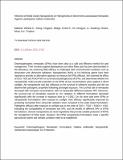| dc.contributor.author | Makirita, Winisia | |
| dc.contributor.author | Zhang, Fengqin | |
| dc.contributor.author | Mbega, Ernest | |
| dc.contributor.author | He, Nongyue | |
| dc.contributor.author | Li, Xiaolong | |
| dc.contributor.author | Chacha, Musa | |
| dc.contributor.author | Liu, Tonghua | |
| dc.date.accessioned | 2020-03-06T08:03:27Z | |
| dc.date.available | 2020-03-06T08:03:27Z | |
| dc.date.issued | 2020-03-01 | |
| dc.identifier.uri | https://doi.org/10.1166/jnn.2020.17329 | |
| dc.identifier.uri | http://dspace.nm-aist.ac.tz/handle/123456789/605 | |
| dc.description | This research article published by American Scientific Publishers, 2020 | en_US |
| dc.description.abstract | Entomopathogenic nematodes (EPNs) have been cited as a safe and effective method for pest management. Their virulence against lepidopterans and other foliar pest has been demonstrated in the laboratory, but achieving field efficacy is challenged with environmental conditions such as desiccation and ultraviolet radiations. Nanoparticles (NPs) as UV-blocking agents have been reported to provide an alternative approach to enhance the EPNs efficacy. We screened the effect of ZnO, TiO2 and Fe3O4 NPs on survival and pathogenicity of EPNs, and determined whether the nanoparticles could provide protection to the EPNs at low concentrations when applied in direct sunlight. All nanoparticles had less influence on the survival of infective juveniles and did not deprive their pathogenic properties following prolonged exposure. The survival rate of nematodes decreased with increased concentrations, with no measurable difference between NPs. Moreover, the survival rate of nematodes exposed to UV radiation in different formulation decreased significantly with the increase in exposure time (p < 0.001). On the other side when EPNs in nanoparticles formulations were exposed to sunlight, their efficacy significantly improved by protecting nematodes from ultraviolet radiation when compared to the water-based formulation. Pathogenic efficacy after exposure to sunlight was in the order of ZnO > TiO2 > Fe3O4 > H2O, indicating the compatibility of nematodes and NPs, and the benefit of different NPs in EPNs formulations. General nanoparticles are novel ingredients that provide suitable protection of EPNs for management of foliar pests. However, the EPNs nanoparticles formulation under a specific agricultural system and climatic condition need to be established. | en_US |
| dc.language.iso | en | en_US |
| dc.publisher | American Scientific Publishers | en_US |
| dc.subject | Entomopathogenic Nematodes | en_US |
| dc.subject | Galleria mellonella | en_US |
| dc.subject | Steinernema carpocapsae | en_US |
| dc.title | Influence of Metal Oxides Nanoparticles on Pathogenicity of Steinernema carpocapsae Nematodes Against Lepidopteran Galleria mellonella | en_US |
| dc.type | Article | en_US |

